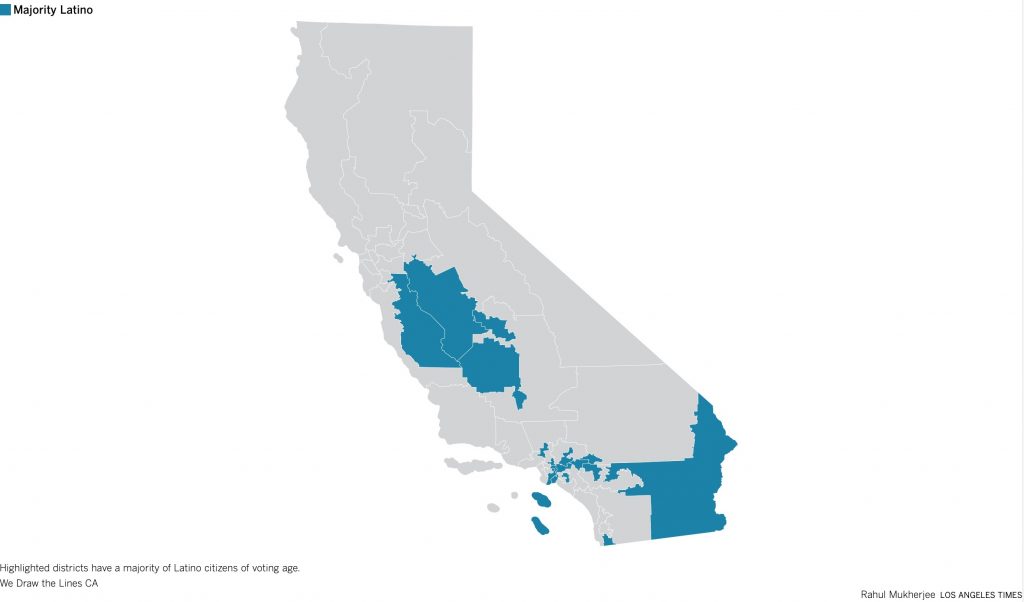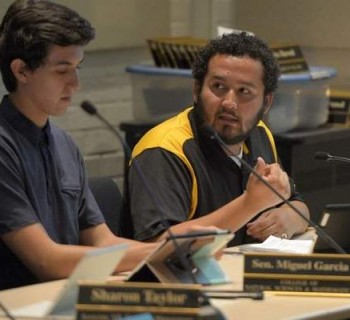Nearly one-third of the state’s 52 new congressional districts would have a majority of Latino citizens of voting age under the new maps.
By Seema Mehta, Melanie Mason, John Myers | LATimes | DEC. 20, 2021
Latino voters would see a major boost in political clout under new congressional and legislative districts approved unanimously Monday by the independent citizen panel charged with redrawing the state’s political map.
Although the panel, created by voter initiative in 2008, does not take partisan balance into account in drawing district lines, the maps it produced all but guarantee that Democrats will retain super majorities in the Legislature and their current lopsided majority in California’s congressional delegation.
Nearly one-third of the state’s 52 new congressional districts would have a majority of Latino citizens of voting age under the new maps. That’s an increase of three districts even as California lost a seat for the first time in its history because its population did not grow as fast as other states’.
Latino civil rights advocates said the increase in political power — which probably will lead to an increase in the number of Latino representatives — was fitting since much of the state’s population growth over the past decade has taken place in their communities.
“This is a substantial increase in the potential for candidates supported by the Latino community to be elected to Congress,” said Thomas A. Saenz, president and general counsel of the Mexican American Legal Defense and Educational Fund.
“It’s a long time coming and appropriate for a state that is now 40% Latino in population and 27% of registered voters,” Saenz said.
Advocates for Black and Asian American voters, who had feared their communities’ voices would be diminished under earlier drafts of the maps, said they were pleased by the final product.
The commission managed to avoid pitting one minority group against another, said James Woodson, policy director of the California Black Census and Redistricting Hub.
The key question was “how can we expand Latino political power while continuing to protect Black political power?” Woodson said. “It was doable, and I think the commission got there eventually, with some pushing. We landed in a good place.”
The commission must formally submit its maps to the Secretary of State’s office by Dec. 27. Candidates have a mid-March deadline for filing for office, with primary elections held in June.
The state’s 42 Democratic congressional incumbents largely fared well in the once-a-decade process of redistricting.

“Democrats gained some electoral opportunities,” said Evan McLaughlin, vice president of Redistricting Partners, a Sacramento-based firm that consults with local governments.
On the other side of the political aisle, nearly half the state’s 11 Republican members of Congress will see their districts grow more blue — putting their political futures more at risk.
“Whereas Republicans are on offense in most of country, they could be on defense in California,” said redistricting expert David Wasserman, senior editor of The Cook Political Report.
Rep. Mike Garcia of Santa Clarita, for example, won last year by 333 votes. His district, which stretches over much of northern Los Angeles County, will grow more Democratic partly because of the loss of Simi Valley. Garcia blasted the commission as biased.
“The commission has shown they were not acting independently when they drew all of the Democratic incumbents into safer seats while making five out of the 11 Republican districts more vulnerable, but I know we will win in this new district regardless,” he said in a statement to The Times.
Earlier this month, Rep. Devin Nunes of Tulare, whose current district also became substantially more Democratic, announced he would leave Congress before the end of this year to take a job with the new media organization that former President Trump is planning.
In addition to those two, Reps. Michelle Steel of Seal Beach, David Valadao of Hanford, Ken Calvert of Corona and Tom McClintock of Elk Grove would have fewer Republican voters in their districts.
The crunch for the GOP reflects the state’s political demographics — Republicans account for fewer than one-quarter of California’s registered voters and are heavily out-numbered in the state’s major population centers.
Under the new lines, at least a half dozen congressional seats could be considered competitive in the 2022 midterm elections and draw significant spending, Wasserman said.
The outcomes of those races could have a major impact on the partisan makeup of Congress because the state has the largest delegation in the nation, despite the loss of a seat.
Republicans are currently favored to retake control of the House of Representatives next year as midterm elections typically go badly for the party in the White House. But Democrats might be able to buck that trend in California, mitigating their losses elsewhere.
Retirements will also be a major factor in reshaping the delegation. In addition to Nunes on the Republican side, four Democrats already have made plans to retire: Reps. Karen Bass of Los Angeles, who is running for mayor, and Jackie Speier of Hillsborough made their announcements this fall. Rep. Alan Lowenthal of Long Beach announced his retirement last week, and Rep. Lucille Roybal-Allard of Downey said Monday that she would not seek reelection.
“Over my many years of public service, I have always strived to do that which is best to help improve my community and my country. After thirty years in the House of Representatives, the time has come for me to spend more time with my family,” Roybal-Allard said in a statement.
Los Angeles County will lose one representative under the new lines, reflecting its slow population growth, and Lowenthal and Roybal-Allard, both 80, had been drawn into the same district. Long Beach Mayor Robert Garcia has announced plans to run and is considered a strong favorite for that seat.
In a delegation that includes several octogenarians and septuagenarians who have a five-hour airplane commute each way to the nation’s capital, several more retirements are expected, particularly among the Democrats, who are likely to be in the minority after the midterms.
Some of the most competitive seats will be in the one-time Republican bastion of Orange County, which has been the focus of intense political battling in recent years. In 2018, Democrats won all seven of the county’s congressional seats. Republicans won back two in 2020.
Steel’s likely district will be among the most competitive in the state.
The new map delivered good news for three other Orange County incumbents — Democratic Reps. Katie Porter of Irvine and Mike Levin of San Juan Capistrano and Republican Rep. Young Kim of La Habra. Kim’s district would become more Republican, and the two Democrats appear relatively safe, although all three are expected to face spirited reelection campaigns.
Sam Oh, a political advisor to Steel and Kim, said both women are “weighing their options now that the congressional maps have been finalized and approved by the redistricting commission.”
In other parts of the state, some incumbents, including Reps. John Garamendi of Walnut Grove and Josh Harder of Turlock, will be playing a game of musical chairs to retain a seat in Congress. Because of the way the lines have shifted, they’ll be running in swaths of the state that are substantially new to them. Members of Congress are not required to live in their districts, unlike members of the state Legislature.
The California Citizens Redistricting Commission was created by the state’s voters in 2008 to end gerrymandering, partisan redistricting and incumbent protection in the drawing of legislative districts. In 2010, voters expanded its role to include congressional redistricting.
Made up of five Democrats, five Republicans and four members not affiliated with either party, the panel’s first charge is creating equal-size congressional districts of roughly 761,000 voters. Its second duty is complying with the federal Voting Rights Act to avoid disenfranchising minorities.
Later considerations include creating contiguous districts, trying to respect community boundaries and drawing districts that are geographically compact.
The maps drawn for legislative districts also reflected the state’s sharp demographic changes over the past decade. Because state law requires legislators to reside in the district they represent, the commission’s maps are likely to force some incumbents to run against each other, move to a new home or leave the Legislature after the 2022 elections.
In both houses, Democrats would be poised to maintain or slightly expand their electoral dominance. Early analyses of the new maps by both partisan and nonpartisan groups show Democrats dominate in at least 30 of the 40 state Senate districts and 63 of 80 Assembly districts.
State Senate districts were subject to an additional wrinkle. The upper house’s members serve four-year terms, which means only half of the seats will be on the ballot next year.
The commission’s work this year was significantly complicated by the delay in the U.S. Census reporting population data — a result of the COVID-19 pandemic. That pushed back the start of the redistricting process by more than three months.
Over the last 12 weeks, the commission has been holding marathon meetings and has received more than 34,000 pieces of public comment from elected officials, interest groups and residents over issues as varied as minority and LGBTQ representation, the proposed splitting of cities such as San Jose and Sacramento, and shared interests such as foothill residents who are regularly visited by the state’s curious black bears.
Their work was collegial but at times chaotic. At one point, the commission seemed to mistake a predominantly white neighborhood in Fresno County for a nearby Black enclave.
The commission also faced extensive criticism over its practices, with outside parties questioning everything from the body’s adherence to transparency and open-meeting requirements to one member’s attendance as he appeared to take part in a reality television show.
At times, the process grated on commissioners.
“I’ll miss all the snarky tweets,” commission member Sara Sadhwani, an assistant professor of politics at Pomona College, wrote this month.
Still, several commissioners grew emotional in the lead-up to Monday night’s vote.
“We set out to create fair and representative maps — with Californians,” said Commissioner Patricia Sinay, a Democrat from Encinitas. “Democracy is beautiful and it’s very messy.”







